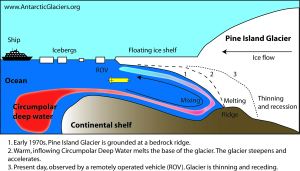News from the Cruise
The ice2ocean team explains why the ocean team is going to Pine Island Glacier.
Pine Island Glacier is changing rapidly – observations from satellites and airborne measurements show that it is thinning and retreating. But atmospheric warming is not the main suspect here, instead it’s a combination of the ocean, climate and local geology to blame! Relatively warm circumpolar deep water (still close to freezing point though!) is transported onto the continental shelf in this area of Antarctica, and is responsible for melting the lower part of the ice shelf (see the picture below from the fantastic Antarctic Glaciers website).
Schematic showing what’s going on at Pine Island Glacier (from AntarcticGlacier.org)
Notice how the bedrock is sloping off downwards on the right hand side? That’s another reason why Pine Island Glacier’s retreat is now considered irreversible – the bottom of the glacier is below sea level, so once the ocean starts moving the glacier backwards, it’s easier for the glacier to just keep moving downhill.
The research on the cruise focusses firstly on how this water gets on to the continental shelf and secondly what is happening at the front of the ice sheet. Seagliders and Autosub can both be controlled by computers and after they are launched from the ship they will target specific areas of the ocean that interest researchers. We will also be putting oceanography instruments on a number of seals in the area – the seals dive deep underwater and by tagging them we can record data over a longer period of time than the 30 days of the cruise. The tags will fall off naturally when the seals shed their fur.
We’re very keen to discover why Pine Island Glacier is thinning and retreating. If we can understand the processes causing the glacier to melt we can try to find out whether the ice loss will speed up or maintain it’s current rate. This knowledge will help us make better predictions for future sea level rise.
Via: Ocean2ice blog

